Look at These Adorable Tiny Homes on Wheels Called ‘Housetrucks’

It’s a house, on a truck. (Photo: Michael Coghlan/flickr)
It was the late ‘60s in Los Angeles and Roger Beck had what many people might consider a sweet deal. He was working as a prop maker at Warner Brothers Studios, a creative, union gig at a major studio in a city teeming with Hollywood hopefuls. But he was unhappy. His coworkers were unfriendly and domineering. He wanted freedom, he wanted to flee the “big city” and he wanted to do so in comfort. So he built a house on the back of a 1955 Mercury Montclair.
“I said, ‘North! To Canada!’ But of course it took me five years to get across the border,” says Beck. Thus launched an odyssey that lasted seven years and four progressively elaborate homes on wheels. Or, if you prefer, housetrucks.
It’s easier to say what a housetruck isn’t than what it is: It definitely is not a motorhome or any other commercially produced camper. When Beck moved into his housetruck, motorhomes—or what he describes as “monster, marathon, glitzy, whore house-looking buses”—didn’t exist.
Instead, housetrucks are bespoke homes, built onto some kind of vehicle that the manufacturer probably never intended to become a roving abode. There are housetrucks built into fire-engines, double-decker buses, moving vans, vintage and modern vehicles. They are the descendants of Gypsy wagons and the predecessor of the “Tiny House” movement, which made headlines in the mid-2000s. What the subculture of housetruckers miss in tiny house cool, they more than make up for in amenities: these mobile homes can include multiple floors, rooms, kitchens, bathrooms, porches and verandas. They have bay windows, hardwood floors, wifi, stoves and chimneys. Some look like log cabins, others like regally appointed Victorians. Still others are decorated with massive murals.
Without organization bodies, counting the number of housetrucks is difficult, but it is a phenomena that spans the globe. One Facebook page has over 2,600 “likes”; a New Zealand-focused group has 780 or so members. There are both lone wolves and groups, such as the Gypsy Fair in New Zealand, a nomadic band that peddles artisan wares and also advertise their “heritage” vehicles as part of the attraction. Some housetruckers live in their vehicles full time, others only dream of such a thing.
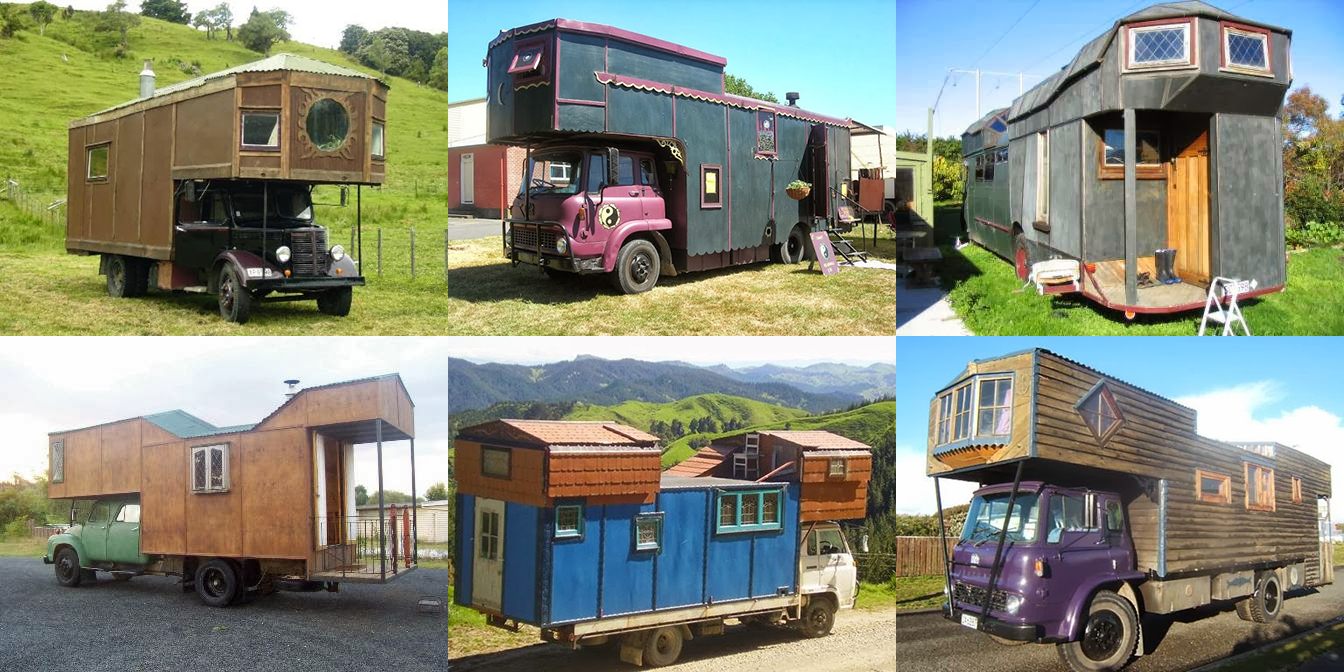
A variety of House Trucks on Mike Sant’s website, htnz.co.nz. (Photos: Courtesy Michael Sant)
When Beck assembled his first housetruck (which he called his “Escape Vehicle” and was really just a bunch of wooden boxes on the back of a car) he didn’t realize he was joining a movement; he just wanted to leave. During downtime at a factory job, he had learned how to bend wires into floral bracelets and other jewelry, which he gave away at Griffith Park love-ins. After fleeing the city, he turned the hobby into a job and, like the Gypsy travelers, began hitting art fairs up and down the West Coast, selling his goods out of the back of his home. He met other housetruckers, became a collector of what he calls “truckology”—snapping photos of others creations, and collecting vintage photos of depression-era Hoover Wagons and other mobile homes. He chronicled his obsession in the book Some Turtles Have Nice Shells. Beck and his book are still sought out by modern housetruckers, who contact him asking for advice.
Beck’s fourth and final housetruck is his masterpiece.
“It’s not just some hippie crash pad with a bunch of mattresses thrown over the back and a bunch of sheets over the windows,” he says.
Built on the frame of a 1952 Federal truck, it weighs five tons. It took him one summer, working “all day, every day”, to build the truck. The “Federal”, as he affectionately calls it, features hardwood floors, stained glass windows, a shingled roof, and a cast-iron potbelly stove. Beck cops to having been “on the hippie trip” and says he thought having an electrical cord was like “having an umbilical cord you have to plug in”. That’s why his house had an oak icebox instead of a refrigerator. In cold weather he stoked the stove; when it got too hot he would pop open the windows above his sleeping loft and “stand up through the skylight butt naked and cool off.”
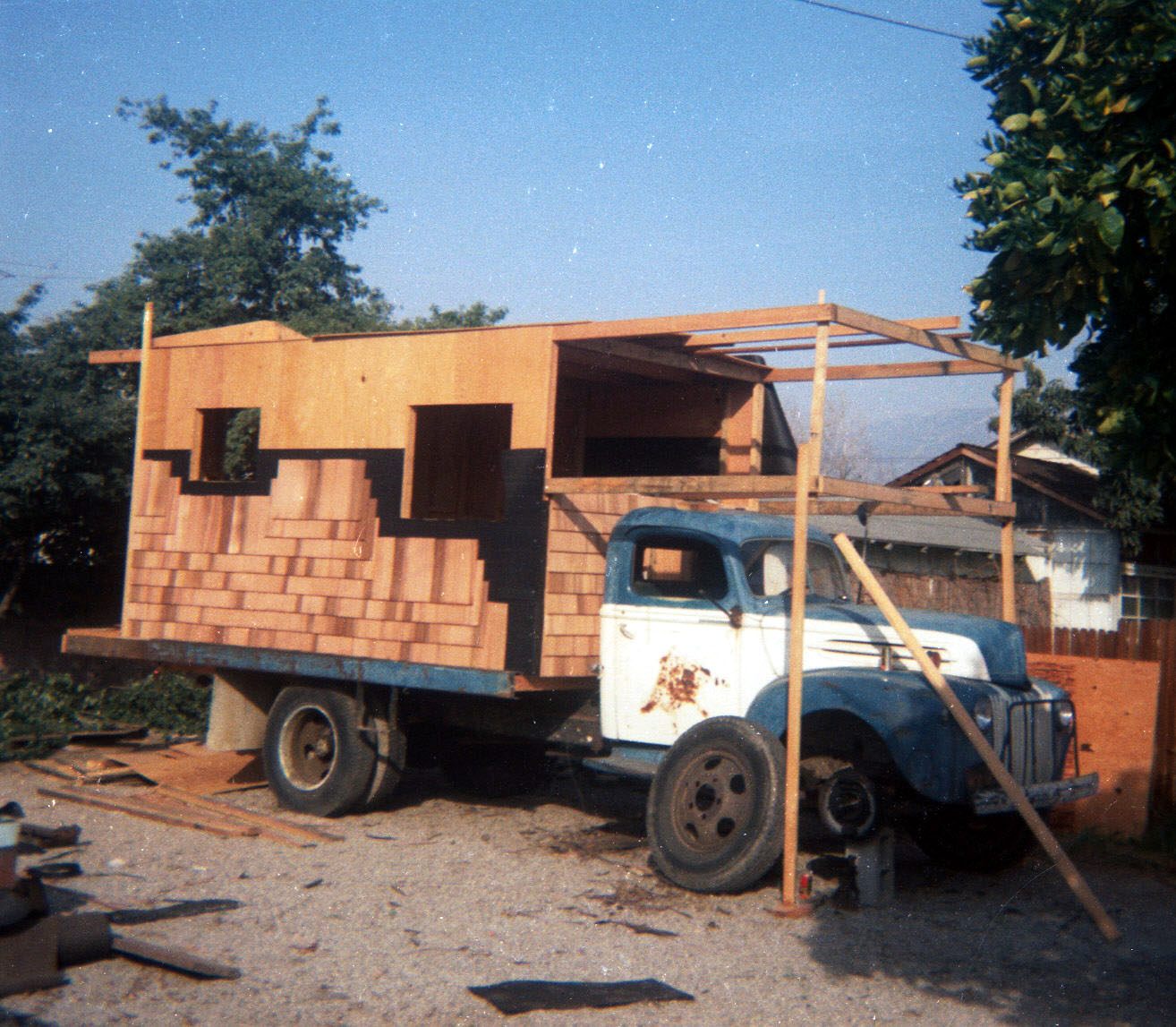
Construction on a house truck. (Photo: Roger Beck)
Beck’s housetruck, though large, was able to carry him into remote areas where he could live in a solitary fashion surrounded by trees. This, too, is an advantage over motorhomes, according to Beck, which are really built for highways and not dirt roads.
Beck occasionally traveled with a group of housetruckers that called themselves the “Northwest Touring Company”. They once applied for a $50,000 grant from the National Endowment for the Arts and were politely refused. But mostly Beck traveled alone until he met a woman and fell in love. She and her young daughter moved into the Federal, and Beck built his stepdaughter a sleeping loft and corral for her toy ponies. That lasted two years before they decided the transient life of a craftsman wasn’t enough to support them. They settled down in Eugene, Oregon. Beck runs a cabinet-making business, and the Federal is parked outside it.
“It served me well, it was a turtle,” says Beck. “It really slowly climbed those mountain passes.”
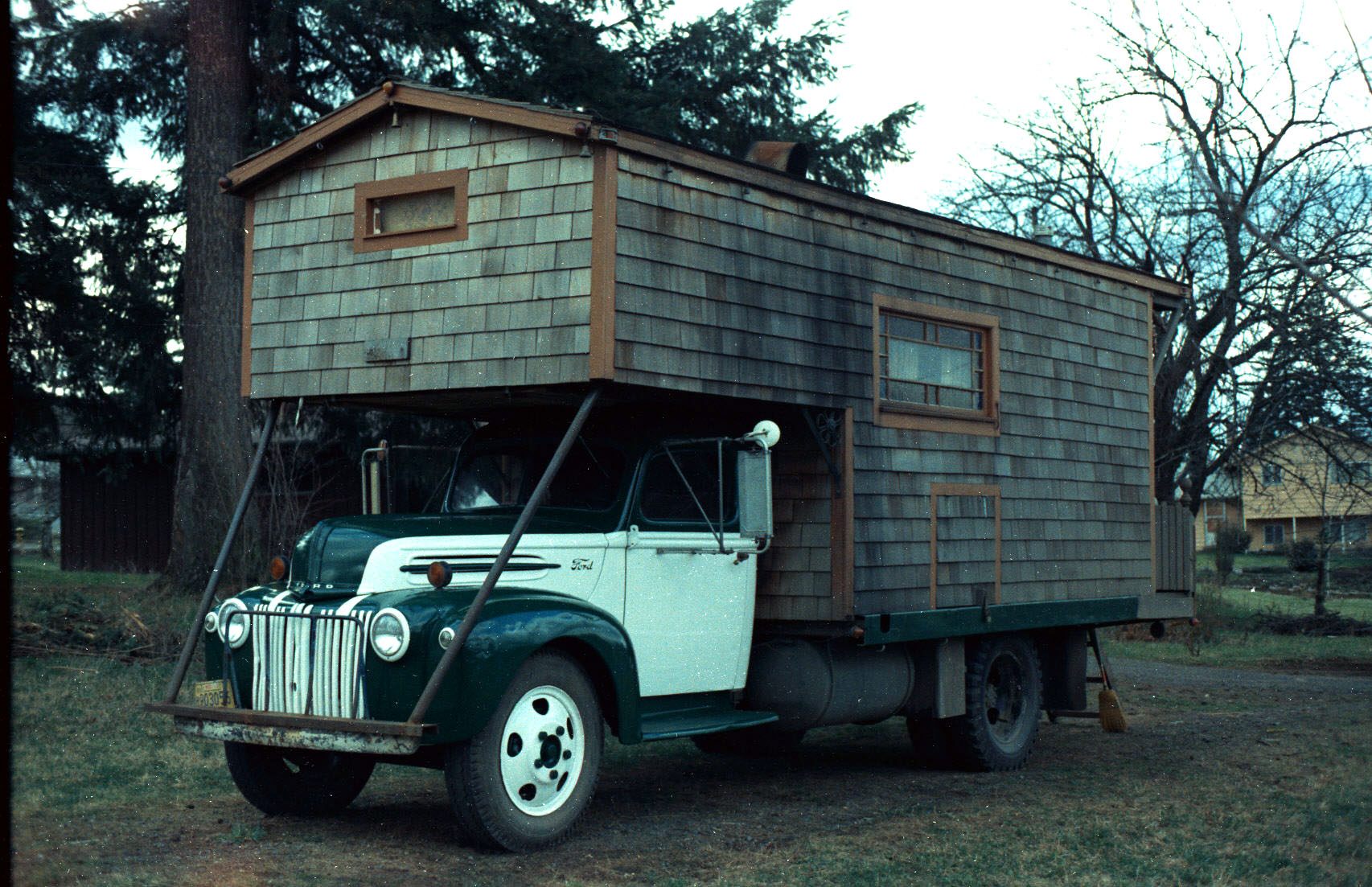
The finished house truck. (Photo: Roger Beck)
Today, housetruckers don’t have to chance across like-minded folks on the road to network; they can just pop onto a website like Housetrucks NZ, where New Zealand house truck aficionados share pictures and log in to the forum section to ask for advice on installing solar panels and other topics.
Mike Sant is an administrator of Housetrucks NZ and has wanted a housetruck since he was a teenager. He realized his dream 15 years ago and “wouldn’t give it up for anything.”
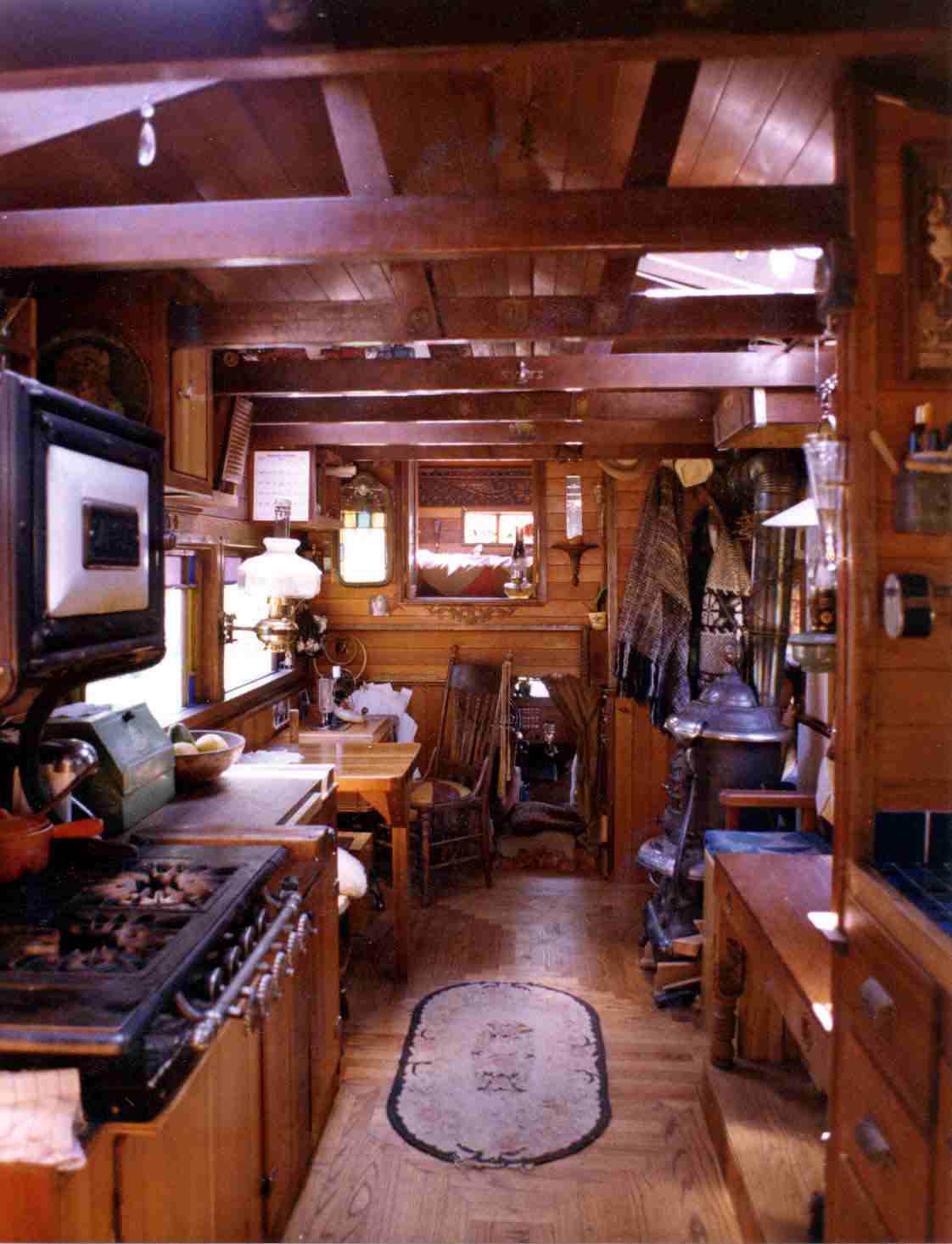
The interior of a house truck. (Photo: Roger Beck)
Sant, who sports a long, wild grey beard and peppers his Facebook feed with bawdy jokes (a photo of a note over a sink reads “Treat your dishes like your partner, don’t let others do them”) drives a 30-foot-long housetruck that he calls the “Stop and Stare”.
“I’ve got three bedrooms, a lounge, a kitchen a veranda, a patio,” he says. (His veranda is on the roof, so it affords a bit of a view as well.) The Stop and Stare has solar panels, a dashcam (for recording “idiots on the road” who can’t seem to grapple with Sant’s massive rolling home), and is strapped with motorbikes and bicycles for commuting. Sant, who is a semi-retired “jack-of-all-trades” does not live fulltime in his housetruck, but hopes to at some point. For now, he settles for long trips. During a stint on a farm, Sant picked grapes alongside workers from New Zealand, Germany and France. At the end of long, grueling days, they would congregate at the Stop and Stare; once they threw a dinner for 12.
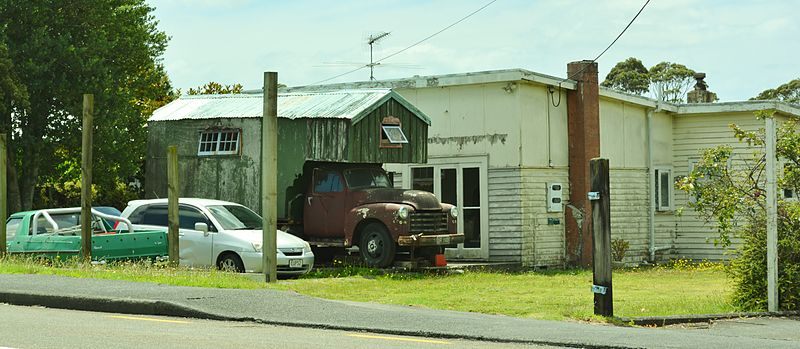
Chev House Truck at Massey, West Auckland, New Zealand. (Photo: GPS 56/WikiCommons CC BY 2.0)
“It was comfortably crowded,” says Sant.
Like Beck, Sant pinpoints freedom as the main appeal of the housetruck life: “We just like the idea of not having to mow lawn, and if we don’t like the scenery today, we can it be somewhere different tomorrow.”
Beck himself, 69, dreams of making a fifth and grander home for his family. Some people today hide their house pride inside a plain U-Haul, with a business name outside of it to make people think it’s a commercial vehicle. That route does not appeal to Beck. “They’re trying to be more stealth and hide,” he says, “whereas I looked at it as being an artist and exhibiting my greatest sculpture.”



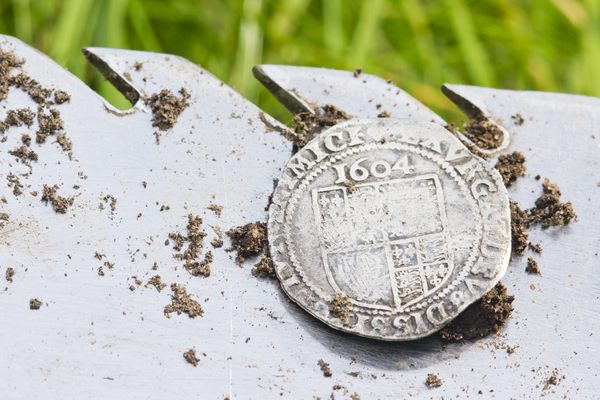





Follow us on Twitter to get the latest on the world's hidden wonders.
Like us on Facebook to get the latest on the world's hidden wonders.
Follow us on Twitter Like us on Facebook